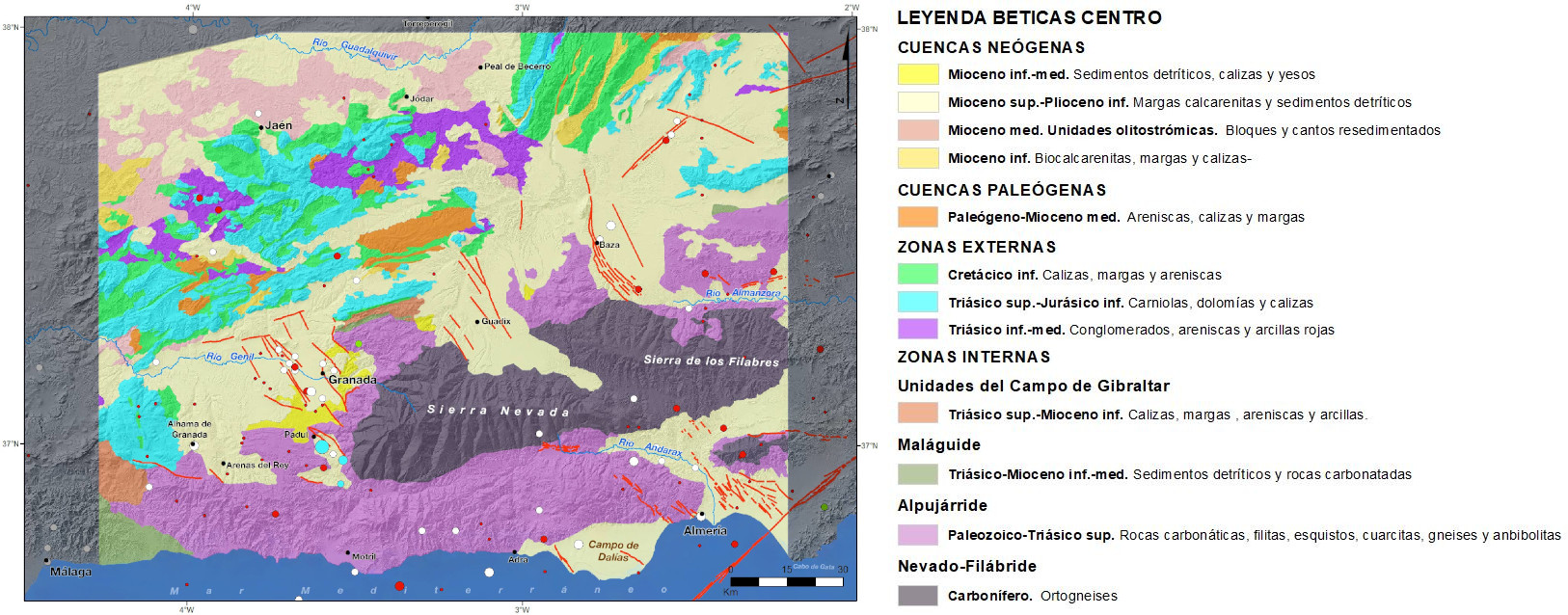
The seismicity in the central sector is concentrated in the interior zone, while the mountainous front remains inactive. As an example of the most significant cortical earthquakes in the aforementioned areas, we can cite that of 1531 (I=VIII-IX) in the Baza basin, where 40 people died, 1804 (I=VIII-IX) in the Dalías basin, which produced great destruction in Dalias, Berja and Roquetas and 407 victims, 1431 (I=VIII-IX) and 1884 (I=IX-X) in the Granada basin or 1972 (I=VII) in the Almanzora basin, the Granada basin being the most seismically active. The very deep earthquakes with epicentres south of Granada recorded are possibly related to the tectonic history of the arc of Gibraltar, on which there is no unanimous agreement. The proposed models consider convection or delamination processes or subductions of different types generally accompanied by roll-back processes, etc. Further north, already on the border between the Betic mountain ranges and the Iberian massif, in the eastern part of the Guadalquivir basin in the area of Torreperogil (Jaén), thousands of earthquakes of magnitudes less than 4 have been recorded since 2010 with a predominant mechanism of rupture. Slightly further west, also in the Guadalquivir basin, the earthquake of 1169 in Andújar (Jaén) of intensity VIII-IX took place and in the subbetic domain the two earthquakes of 1951 of M5.2 and 5.3 in the area of Alcaudete (Jaen).
This area extends from the mountains of Malaga to the eastern edge of the bay of Almeria. The highest peaks are in the Sierra Nevada and Los Filabres mountains with heights from 2500 to almost 3500 m, below which the continental crust reaches its greatest thickness of 35 (Strait of Gibraltar)-40 km. The contact between the continental crust of the region and the oceanic crust of the Alboran Sea is net while towards the Iberian massif it is gradual. The northern part is occupied by the valley of the Guadalquivir and the external areas of the mountain range. It is a deformed Mesozoic blanket that has become detached from the variscose base. It is divided into two domains. The Pre-Baetic is little represented in this area while the Sub-Baetic rides on the Pre-Baetic to the east of Jaén and they are very deformed and allochthonous units that come to present brechoid structures as well as numerous Triassic salt diapirs whose mobility continues nowadays.
The internal areas emerge in the southern sector and reach the Alboran Sea. They are Paleozoic materials that come from the Alboran micro plate. It is a pile of superimposed tectonic units whose original contacts with each other were dipping faults but were later transformed into normal extensional take-off faults. Three domains can be distinguished which, from top to bottom, are The Maláguide Complex that is very well represented in the province of Malaga, constituting most of the Mountains of Malaga. The Alpujarride Complex outcrops mainly in the mountain ranges of the provinces of Granada and Málaga, and the lower parts of some units correspond to the deep continental crust affected by a metamorphism of ATo.
The Nevado-Filábride Complex is the lowest of the set of superimposed mantles in the internal zone. It outcrops in tectonic windows under the materials of the Alpujarride Complex. The outcrops are restricted to the central and eastern part of the Betic mountain range, in the nuclei of two E-W direction anti-forms: Sierra Nevada, which extends longitudinally for more than 90 km with a width of about 35 km, and the Sierra de los Filabres. In the first one there is a generalized schistosity, with several mantles of corridor. In the Filabres, the general structure is a large E-W anticline.
The post-tortogenic Neogene Quaternary basins are intra-chain basins that were generated during the elevation of the mountain range and are located indistinctly in the External, Internal or on the contact between both areas. In this area, the main ones are the Granada and Guadix-Baza basins, which constitute the largest intramountain basins of the Neogene and Quaternary of the Béticas mountain ranges. The former is limited by very active tectonic edges, with a current state of tensional stress in the NE-SW direction. In general, in the areas of the Neogene basins there are two main types of active faults: those with an E-W direction, with predominantly transcendent movement (present in the Almanzora and Alpujarras corridors) and those with a NW-SSE direction in the basins of Dalías, Granada and Guadix-Baza, which accommodate an extensive regime in an ENE-OSO direction.
In the Guadix-Baza basin, the rise of the Sierra Nevada separated this great basin and that of Granada from the Mediterranean. The Baza fault is a normal fault of approximately 37 km in length, which divides the basin into the two sub-basins of Guadix and Baza.
On the other hand, the GNSS measures show a general shift of the central sector of the Béticas towards the west with respect to Eurasia compatible with an extensive regime.
| © Instituto Geográfico Nacional - C/ General Ibáñez de Ibero, 3. 28003 Madrid - España.
ign@fomento.es |